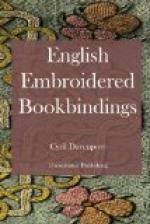During the first half of this period the English leather binders were the finest in Europe; during the second, the Germans pressed them hard, and when the large panel stamps, three or four inches square and more, were introduced in Holland and France, the English adaptations of them were distinctly inferior to the originals. The earliest English bindings with gold tooling were, of course, also imitative. The use of gold reached this country but slowly, as the first known English binding, in which it occurs, is on a book printed in 1541, by which time the art had been common in Italy for a generation. The English bindings found on books bound for Henry VIII., Edward VI., and Mary I., all of which are roughly assigned to Berthelet as the Royal binder, resemble the current Italian designs of the day, with sufficient differences to make it probable that they were produced by Englishmen. We know, however, that until the close of the century there were occasional complaints of the presence of foreign binders in London, and it is probable that the Grolieresque bindings executed for Wotton were foreign rather than English. Where, however, we find work on English books distinctly unlike anything in France or Italy, it is reasonable to assign it to a native school, and such a school seems to have grown up about 1570, in the workshop of John Day, the helper of Archbishop Parker in so many of his literary undertakings. These bindings attributed to Day, especially those in which he worked with white leather on brown, although they have none of the French delicacy of tooling, perhaps for this reason attack the problem of decoration with a greater sense of the difference between the styles suitable for a large book and a small than is always found in France, where the greatest binders, such as Nicholas Eve and Le Gascon, often covered large folios with endless repetitions of minute tools whose full beauty can only be appreciated on duodecimos or octavos. The English designs with a large centre ornament and corner-pieces are rich and impressive, and we may fairly give Day and his fellows the palm for originality and effectiveness among Elizabethan binders. In the next reign the French use of the seme or powder, a single small stamp, of a fleur-de-lys, a thistle, a crown, or the like, impressed in rows all over the cover, was increasingly imitated in England, very unsuccessfully, and, save for a few traces of the style of Day, the leather bindings of the first third of the century deserve the worst epithets which can be given them.
Until, however, French fashions came into vogue after the Restoration, English binders had never been content to regard leather as the sole material in which they could work. Embroidered bindings had come early into use in England, and a Psalter embroidered by Anne Felbrigge towards the close of the fourteenth century is preserved at the British Museum, and shown in one of Mr. Davenport’s illustrations. In the




